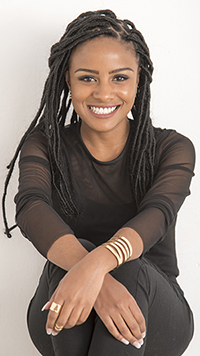
Candice Thikeson, a Master’s
student in Arts History and
Image Studies at the University
of the Free State.
Photo: Anja Aucamp
“I was once told that I looked ‘immaculate’, as always. We use the word ‘immaculate’ to describe the Virgin Mary, does it get better than that?”
To everyone else, she may be a Mandela Rhodes Scholar, Bright Young Mind and Abe Bailey Travel Bursary candidate, but there is more to this beauty that meets the eye.
Relating to women in the humanities field
Candice Thikeson, who is currently a Master’s student in Art History and Image Studies, says “I have a very strong spiritual foundation and my relationship with God really fuels everything I do. I also think being intentional about building great relationships with your family and friends is imperative.”
She says she has been inspired by different people at different stages of her life and draws a great deal from academics, creatives and activists. She relates best to women who are in the humanities and draws inspiration from the likes of Nigerian novelist, Chimamanda Ngozi Adichie, and Kenya-born, Somalian poet Warsan Shire.
“I love how they are able to comment on some of the most pressing issues black women face through beautiful and poignant writing. I also admire how frank these women are, something I’m still learning to be,” Thikeson says.
Pursue something you are genuinely interested in
The biggest misconception people have of her is that she studies art and she is working towards becoming an artist. “Fine art and art history is not the same thing. I don’t paint or make art at university, and I really don’t enjoy being called an artist.”
When asked about how she has become so successful at such a young age, she reiterated the cliché: “pursue something you are genuinely interested in and passionate about”. She adds, “if you are really good at what you do, your gift will make room for you in your field”.